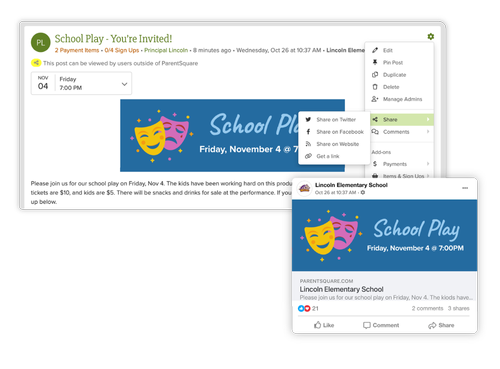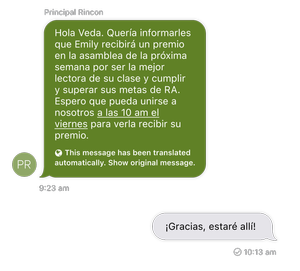
When it comes to building strong relationships between schools and families, effective communication is essential. Administrators and faculty members who know how to communicate clearly and consistently with parents and guardians—in a way that resonates with them—don’t only make learning smoother and less stressful for students, but they also help build loyal, supportive, trusting school communities.
If you are ready to improve your school’s communication efforts so that you can foster strong bonds with student families and create the best schooling experience possible for students, consider trying out some of the following strategies.

1. Send out a regular newsletter
Good communication doesn’t necessarily mean a lot of communication. Too many emails, texts, handouts, or letters from school can overwhelm students and their parents/guardians. Instead, try sticking to one simple newsletter. A weekly or monthly newsletter is frequent enough that it allows everyone to stay in the loop, without getting overwhelmed and then checking out due to information overload. Using school communication software like ParentSquare makes it really easy to write the newsletter and then get it out to students’ families electronically.
2. Use instant chat applications for brief, important reminders
If your school wants help finding ways to better engage parents and guardians, a school-specific messaging software may help. Teachers can use the messaging software to send concise and clear, regular (instant) reminders to parents/guardians about upcoming events or deadlines. Messages like these can help ensure parents don’t overlook important events or miss crucial deadlines. Messaging software also provides a platform where teachers can get forms, documents, and important information to parents quickly and electronically.
3. Hold monthly faculty office hours
Don’t just have parents and teachers meet twice a year for conferences. Instead, hold monthly faculty office hours where parents or guardians are welcome to come in and chat with their child’s teacher. Office hours exist for the benefit of both families and teachers, since they give parents more opportunities to address concerns, and they allow teachers to open the lines of communication with parents or guardians who can offer better support for their kids at home.
4. Host teacher weekly chats
Effective school communications are not just about teachers and parents communicating. Teachers need to communicate with each other to build a strong team and prevent teachers from siloing off into groups by grade. Have weekly teacher chats to create a strong, bonded faculty where everyone feels supported.

5. Update social media school pages regularly
Today, every school district should have a profile on the most popular platforms to facilitate engagement. Social media allows schools to share important updates and forge bonds with people throughout the community. A tool like ParentSquare’s social share feature makes posting to social media easy. The tool allows schools and districts to share ParentSquare posts across Twitter, Facebook, and their website—which means parents and guardians can receive an update across the web with just one quick click of a button.
6. Offer weekly shout-outs
One of the best ways to build a strong community is to foster positivity and celebrate the good happening at school. For regular infusions of positivity, offer weekly shout-outs that celebrate best practices in classrooms and excellence in school activities. Have teachers nominate a community member (student, fellow teacher, staff member, etc.) who has done something excellent —then shout them out in the weekly newsletter. Draw attention to all the awesome things going on in your community.
7. Have monthly brainstorm sessions
It is easy during the school day for teachers and administrators to get swept up with the routine of school operations—and to feel stuck in a rut. Hold monthly brainstorming sessions where all faculty attend and offer creative ideas about how to approach problems at the school. By getting input from the rest of the faculty, teachers who feel stuck can approach the classroom feeling reinvigorated and with new vitality and energy.
8. Make twice-yearly parent-teacher conferences mandatory
Not every parent or guardian will be able (or need) to come to a monthly faculty office hour. However, each parent or guardian should meet with their child’s teacher at least twice a year for a parent-teacher conference. Stay on top of communication regarding conferences so that families know when and where conferences will be early, and so that you increase the chances of every parent or guardian participating. ParentSquare’s parent-teacher conference scheduling tool provides the opportunity for every child’s parent or guardian to talk about their progress with a teacher. It makes maximizing parent-teacher conference participation feel easy with simple online scheduling and automated reminders.

9. Send out surveys
Gauge how parents and guardians are feeling about the school—and their child’s experience at school—by sending out surveys. Polls and surveys are excellent ways for teachers and school administration to hear what’s working and what could be improved. They are also a great way to make parents know that you value their voice. ParentSquare makes it easy to run school surveys for parents by offering pre-built templates, multi-language versions, and pre-populated fields.
10. Create a back-to-school resource
It can help build strong ties with parents if you start the school year off with all the important information they need to know in one place. This can be created as a newsletter or just a post that lists information families may have throughout the year. You might include:
- Scheduled events inside and outside of the classroom
- Curriculum information
- Tips on homework and learning strategies
- FAQs
- Ways you’ll recognize students throughout the year
- Classroom expectations
ParentSquare’s school communication network allows teachers to share classroom updates such as these through a mobile app that families can look back on any time they need a refresher.

11. Send home student work folders
Use student work folders to gather graded papers and send them home for parents and guardians to see and sign. Avoid using tangible paper by relying on ParentSquare, which digitizes the whole process. You won’t have to worry about anyone losing a folder at the bottom of a backpack ever again.
12. Take advantage of translated messaging
Teachers won’t always speak the same language as parents or guardians. Make sure you equip them with tools to translate what they need to share with families into a language that they understand. Tech tools like ParentSquare’s text translation make it super easy for everyone to communicate and share important information, regardless of the language they speak.
Conclusion
Effective communication is essential in schools for fostering loyalty with families, shaping the school’s reputation with the public, and building strong internal teams and processes. Consistently communicating with parents and guardians transparently is key for ensuring that parents feel involved and included, and students feel adequately supported.
By using school communication software like ParentSquare, your school can unify all school-home communications among parents, guardians, teachers, and faculty. That way, IT staff only has to teach faculty and staff members one platform to use—and they will use it as long as they work at the school, regardless if they switch grades or positions. Parents/guardians will only have to learn a platform one time—when their student starts school—and then they can rely on a tool they know until their child graduates or leaves. The ParentSquare application offers private and secure school messaging software with text translation designed to provide a safe school communication network. It has tons more helpful tools that simply ParentSquare makes school-home communication streamlined and effective.
Click here to get a demo of ParentSquare software and see how a single platform can help engage all your students’ families.







